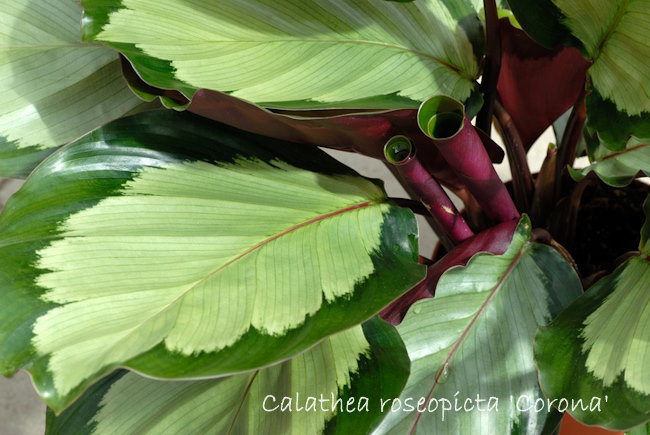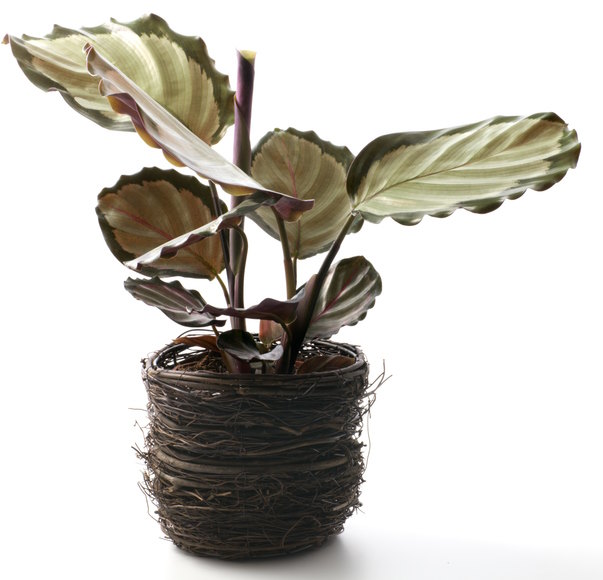Calathea Roseopicta 'Corona' Prayer Plant
Calathea roseopicta 'Corona' prayer plant deserves its place among the showy plants of the Maranta (Marantaceae) family. Spectacularly patterned foliage in bold colors make 'Corona' a favorite among this clan.
Find out how to water, when to repot, and why this handsome houseplant loves humidity.
 Spectacular patterns and colors make 'Corona' a must-have houseplant. Image ©adel66
Spectacular patterns and colors make 'Corona' a must-have houseplant. Image ©adel66Get to Know Corona Prayer Plant
'Corona' is one of the most popular among the named varieties in the Calathea genus. Its handsome markings and colors make it easy to see why. Broad, silvery-green leaves taper to a point and are edged with a wide band of dark green. Even the reddish-color midrib is distinctive on each leaf.
New leaves are curled as they emerge, showing their purplish red undersides. And like its family members, this tropical foliage plant folds its leaves at night as hands in prayer.
Will it bloom indoors? Probably not. In its native Brazil, Calathea roseopicta produces small, white and purple flowers, emerging from green bracts. However, when grown indoors in a pot, they rarely bloom. Calathea flowers are insignificant anyway, compared to the magnificent leaves.
Are Calatheas poisonous to pets? No. According to the ASPCA, they are non-toxic to cats and dogs.
Display Ideas: Group Calatheas with other humidity-loving plants, such as bromeliads and ferns. Or show off a single plant by placing it on a pedestal plant stand.
Caring for Calathea Roseopicta 'Corona'
The secret to keeping Calatheas happy is to provide high humidity. Brown leaf tips indicate the air is too dry. Do anything you can to keep the relative humidity above 50%. Place it on a humidity tray or use a room humidifier. Calatheas also love to be misted with rainwater.
Repot in spring to give it fresh potting mix. Use a pot only 1-2 inches larger -- this prayer plant likes to be slightly pot-bound. Keep the crown of the plant at the same soil level as it was before. Need a new container? Check out stylish, new house plant pots here.
Leaves are naturally glossy. Do not use leaf shine products, because Calathea leaves are sensitive to chemicals. You can clean the leaves by gently wiping them with a soft, damp cloth. Hold one hand under the leaf as you wipe it off to avoid tearing the foliage.
Something bugging your houseplant? Watch for spider mites. Dry indoor air in the winter months encourages these pests to invade house plants, another reason to keep the humidity up. You'll first notice faint webbing on the undersides of leaves. Don't use an oil-based insecticide on Calatheas because it will damage those beautiful leaves. And if your plant is badly infested, get rid of it. You don't want those harmful pests to invade your other houseplants.
Brown, curled leaves? Older leaves will turn brown and shrivel up. This is normal. Cut them off with scissors or pruners to keep your plant looking neat. Newer leaves with brown edges, or crispy, curled leaves may be suffering from too much fertilizer. Flush the soil with tepid water to remove built-up salts.
 Calathea roseopicta 'Corona' houseplant Image ©vspn24
Calathea roseopicta 'Corona' houseplant Image ©vspn24Calathea Roseopicta 'Corona' Prayer Plant Care
Light: Moderate to bright light. Avoid direct sun that will scorch the leaves.
Water: Keep soil evenly moist spring through fall. Water less often in winter, allowing the potting medium to dry slightly before watering again. Do not allow the soil to get soggy; over-watering may cause root rot and kill the plant. Use distilled water or rainwater because this plant is sensitive to fluoride and salts in tap water.
Humidity: Moderate to high (at least 50% relative humidity). A cool-mist room humidifier works best. Or set plant on a tray of wet pebbles. Mist its leaves with distilled water or rainwater (tap water with chlorine or fluoride can leave white spots on leaves) at room temperature.
Temperature: Average to warm 70-85°F/21-29°C room temperatures.
Soil: Peat moss based potting mix, such as African violet mix.
Fertilizer: Feed every 2 weeks spring and summer with a balanced NPK (such as 10-10-10) water-soluble fertilizer, diluted by half. In fall and winter, feed monthly. New leaves that emerge light in color may be lacking iron.
Propagation: Division in spring or early summer. Ease plant out of its container and carefully separate rhizomes, ensuring that each plant has roots attached. Pot each division in its own container. Keep Calathea roseopicta shaded from sunlight and maintain humidity.


